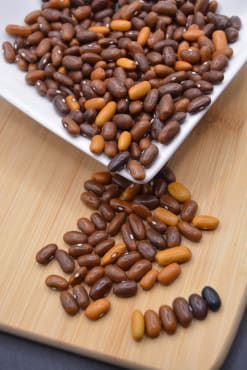(100 days) Open-pollinated. This productive dry bean has a rich meaty flavor that can stand alone in dishes. Bred by Carol Deppe from Gaucho and Beefy Resilient Grex, a gene pool developed from a cross of Gaucho and Black Mitla—so Brown Resilient is about ¾ Gaucho and ¼ Black Mitla. Yields comparable to Jacob’s Cattle or Soldier, about 15 lb per 100 row feet. Can produce well in areas with cold spring seasons and summer nights that drop into the 50s. The variety is a mix of bushes and short-vined types. Seeds are 80–90% brown; the rest are gold or black. When Carol tried selecting for a pure brown bush line, she discovered a few things: the lines that had some yellow and black beans had much higher yields than pure brown lines; also, the short-vined types yielded well, could be grown just like bushes, and seemed to be more resistant to drought. As Carol pointedly quips, “If I were intending to get a PVP or patent on my varieties I would have to make a uniform bush version with all brown beans that was wimpier and lower yielding than Brown Resilient. But I’m not and I don’t.” OSSI. Breeder Royalties. ①
Brown Resilient Shell & Dry Bean - Organic
Brown Resilient Shell & Dry Bean - Organic
(100 days) Open-pollinated. This productive dry bean has a rich meaty flavor that can stand alone in dishes. Bred by Carol Deppe from Gaucho and Beefy Resilient Grex, a gene pool developed from a cross of Gaucho and Black Mitla—so Brown Resilient is about ¾ Gaucho and ¼ Black Mitla. Yields comparable to Jacob’s Cattle or Soldier, about 15 lb per 100 row feet. Can produce well in areas with cold spring seasons and summer nights that drop into the 50s. The variety is a mix of bushes and short-vined types. Seeds are 80–90% brown; the rest are gold or black. When Carol tried selecting for a pure brown bush line, she discovered a few things: the lines that had some yellow and black beans had much higher yields than pure brown lines; also, the short-vined types yielded well, could be grown just like bushes, and seemed to be more resistant to drought. As Carol pointedly quips, “If I were intending to get a PVP or patent on my varieties I would have to make a uniform bush version with all brown beans that was wimpier and lower yielding than Brown Resilient. But I’m not and I don’t.” OSSI. Breeder Royalties. ①
Additional Information
Shell and Dry Beans
- Average 130 seeds/2oz packet. 2 oz packet sows 25 ft; 1 lb, 200 ft. All bush beans except where noted.
- Days to maturity are from emergence after direct sowing.
Culture: In conditions of high nitrogen fertility some bush beans may develop vines in moist hot weather. Tender, will not survive frost. Plant 3–4 seeds/ft in rows 24–30" apart. Pick frequently for maximum yields, but avoid disturbing foliage in wet weather to prevent spread of fungal diseases.
Harvest at shelling stage when beans are plump inside pods. For dry beans let pods dry hard on the vine until pressing the beans with your fingernail leaves no indentation. If heavy rains or hard frost threaten before full dry maturity, either pull plants by the roots and hang them in a dry place to finish; or pick pods into mesh or paper bags and finish drying them indoors before threshing.
Beans
- All beans are open-pollinated.
- Days to maturity are from emergence after direct sowing.
Culture: Tender, will not survive frost. Inoculate with a legume inoculant, then plant seeds 3–4" apart in rows 24–30" apart after all danger of frost has passed and soil has warmed. Minimum germination soil temperature 60°; optimal range 70–80°. White-seeded beans are generally more sensitive to cold soil temps than dark-seeded varieties. Legumes have moderate fertility needs and can fix their own nitrogen. Excessive nitrogen may induce some bush varieties to develop vines in moist hot weather.
Saving Seed: Saving bean seed is easy! Leave pods on the plants to dry. Hand shell, or stomp pods on a tarp. To ensure true-to-type seed, separate varieties by 30 feet.
Diseases:
- ANTH: Anthracnose
- BBS: Bacterial Brown Spot
- CBMV: Common Bean Mosaic Virus
- CTV: Curly Top Virus
- DM: Downy Mildew
- HB: Halo Blight
- NY 15: NY 15 Mosaic Virus
- PM: Powdery Mildew
- PMV: Pod Mottle Virus
- R: Rust
- SC: Sclerotina
White mold, Sclerotinia sclerotiorum, affects more than 300 plant species. In beans, low humidity, good air circulation and wider spacing, both between plants and between rows, reduce the likelihood of this soil-borne infection.
Germination Testing
For the latest results of our germination tests, please see the germination page.
Our Seeds are Non-GMO

All of our seeds are non-GMO, and free of neonicotinoids and fungicides. Fedco is one of the original companies to sign the Safe Seed Pledge.







